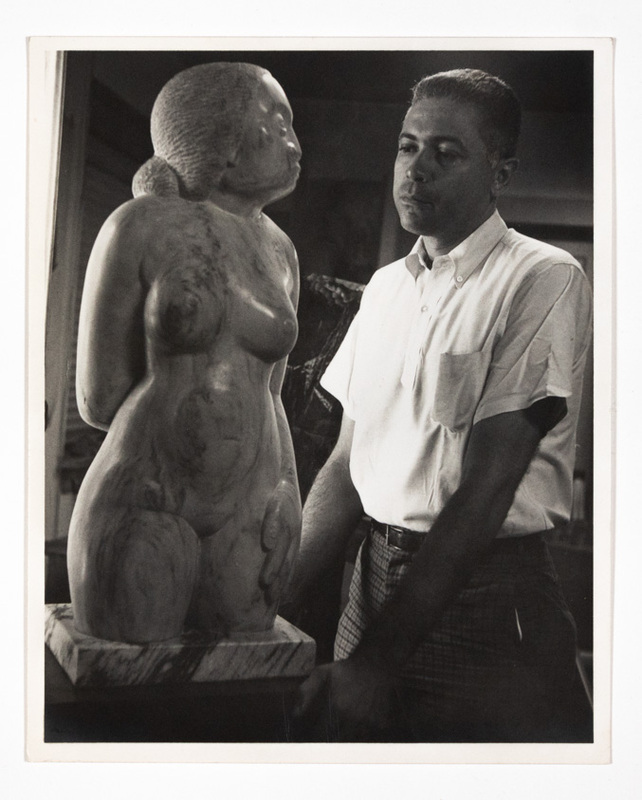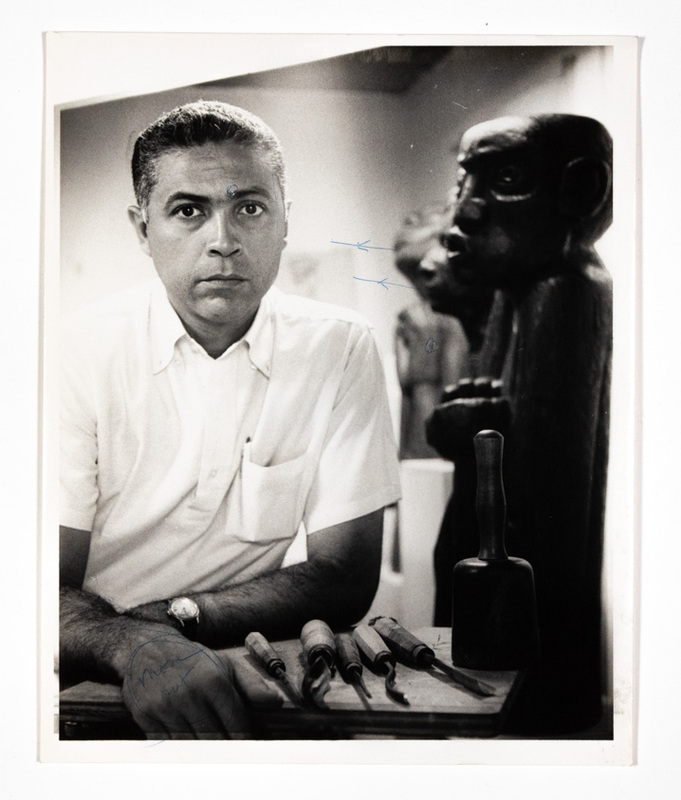Apprenticeship to Sculpture
The Baltimore-born son of a college registrar and a former schoolteacher, Wilson originally entertained hopes of entering the architectural profession. His experiences of virulent racism during the Second World War, however, convinced him of the futility of such a career as a Black man in segregated American society. When he enrolled at the University of Iowa in 1946 under the G.I. Bill, it was to study art, a childhood passion that had long lain dormant.
Wilson went on to earn his M.A. in 1951 from Iowa, then the largest graduate program in fine art in the country. There, he learned the techniques of direct carving in marble, stone and wood, which he would soon apply to works that sought to introduce the Black figure into the traditions of American sculpture.
Wilson took these skills to North Carolina College (N.C.C.), a historically Black school in Durham, joining its art faculty in 1951. The thirteen years Wilson taught there saw him gain recognition as a talented sculptor, first regionally and soon nationally. His time in the South also coincided with the birth of the modern civil rights movement, in which he was an active participant, joining efforts to desegregate public accommodations with his students and the Congress of Racial Equality (C.O.R.E.).
Object Labels
Cybele, 1954
Georgia marble
Binghamton University Art Museum, Binghamton, N.Y., purchase from the artist 1966.180
In the ancient Greco-Roman pantheon, Cybele was the great mother of the gods and of all earthly life, a personification of the maternal and the fertile. Soon after completing Cybele, Wilson described the figure as a representation of “the universal woman,” her face a hybridization of “the three ethnic groups,” integrating African, Asian and European characteristics. It was also a polemical intervention into the history of Western sculpture, insisting on a racialized beauty that warranted tribute in marble, one of the most prestigious of sculptural materials.
Completed in 1954, the origins of Cybele date back to 1952, when Wilson received a Carnegie Corporation grant to outfit a sculpture studio at N.C.C. in order to work on a large block of white Georgia marble. In 1955, it was the first work by an African American to be included in the North Carolina artists’ annual exhibition. Cybele would become Wilson’s most frequently exhibited artwork, a declaration of his ambitions to be recognized as a sculptor of national significance.
Carolyn, ca. 1955
patinated plaster
Patricia and Craig Wilson ’74, MA ’76 collection, Latham, N.Y.
If, in his early work, Wilson sought to give form to a “universal” femininity, he also embraced the particular and individual, as in this bust. Its subject, Carolyn Pride, was a former student at N.C.C. who, by the time she sat for this portrait, was working at the Agricultural and Technical College, another Black institution in nearby Greensboro. Wilson here adopts a naturalist vocabulary, free of the stylizations found in much of his sculpture of the time, to depict the specific physiognomy of the sitter.
The art program Wilson oversaw at N.C.C., like the school generally, had only modest means; he later recalled that “no state would give a Black college an equal amount of money” as a comparable white institution. Carolyn was therefore modeled in inexpensive plaster and then painted to look like bronze. First exhibited at A. & T. College in 1955, it earned him early national recognition when it was awarded a prize for portraiture at the Maryland artists annual exhibition, held at the Baltimore Museum of Art in 1956 – the first award given to a Black artist in the Museum’s history.
Study for Minority Man I, 1957
pencil and conté crayon on paper
Binghamton University Art Museum, Binghamton, N.Y., gift of class of 1966 1966.233
Although direct carving was premised on the sculptor’s pursuit of the demands of the given material and hence tended to eschew the use of preparatory drawings, in this large drawing Wilson explores the pose of his first “Minority Man” sculpture. He pays particular attention to the face, especially in the profile study at left, and to the figure’s clasped hands, which are repeated three times. Should the shoulders be hunched, as at left, or slouched? Wilson appears to be searching for a pose that most clearly demonstrates supplication. Although simplified, these sketches generally lack the quality of caricature Wilson would emphasize in the realized sculpture.
Minority Man I, 1957
North Carolina red hickory
Binghamton University Art Museum, Binghamton, N.Y., gift of class of 1966 1966.236
Caricature – the use of distortion to mock a subject – is uncommon in sculpture, whose permanence seems poorly suited to the punctual satire that is caricature’s primary aim. Wilson turned to exaggeration in Minority Man I, however, precisely to parody the pleading attitude that many whites expected African Americans to adopt: “all they wanted to hear was Blacks sing spirituals,” he remarked later in life, quoting the chorus of “Go Down Moses,” as the Israelites demand of Pharaoh, “Let my people go.”
Wilson carved this work at a time and in a place still defined by the legalized racial segregation enshrined in Jim Crow laws. The civil rights movement was gaining strength following the Supreme Court’s decision in Brown v. Board of Education ruling against “separate but equal” accommodations in education, the Montgomery Bus Boycott, and the contested integration of Little Rock Central High School. In the face of demands for equality, many Americans often preferred to imagine a more docile Black population - an attitude Wilson effectively skewers here.
Minority Man II, 1959
wood
Martin A. Flesher, Jr. collection, Endicott, N.Y.
Two years after his first Minority Man, Wilson returned to the theme, now trading the entreating figure for one of a decidedly more confrontational bearing. The tone is still satirical, in this case caricaturing another trope of Blackness in the white imaginary: the militant who, with a snarling visage, holds one arm aloft in protest while demanding a handout with the other. In both these works, Wilson reclaims racist stereotypes, using hyperbole to show up their absurdity. At this same moment, he imagined creating a parallel “Majority Man” series, which presumably would have taken aim at Black fantasies of whiteness.
In a profile of Wilson from 1960, a critic described him as “very clearly aware of the social role of art and of the part that the artist must take in the intellectual and human concerns of his time.” Black students, first at A. & T. College in Greensboro and soon at Wilson’s own N.C.C., began a sit-in movement early that same year to desegregate businesses such as restaurants and theaters. Wilson would strongly support their efforts, becoming an activist with C.O.R.E.
Hera, ca. 1959
white Italian alabaster
The work is on loan from the Howard University Gallery of Art and Howard University reserves all rights with respect to the work. Washington, D.C.
With this reclining female figure, carved from a piece of translucent alabaster, Wilson returned to the theme of the “universal concept of women,” as he explained to a journalist at the time of its creation. Joining his earlier work Cybele, Hera depicted another mythological figure, the sister and consort of Zeus, king of the Greek gods. Wilson imagined her as a compact figure at rest, designed as a closed form without voids. Because of her recumbent position, a large proportion of the figure rests upon the base plane, making the form particularly suited to carving in a soft stone such as alabaster. The influence of sculptor William Zorach (1889–1966), whom Wilson met while at N.C.C., is evident in both theme and style. A proponent of direct carving, Zorach once remarked that, in this sort of sculpture, “there is no putting back tomorrow what was cut away today. [...] If something goes wrong there is the struggle to right the rhythm. And slowly the vision grows as the work progresses.”
Hera earned Wilson important early accolades, winning a first-place award in a 1959 competition and, two years later, the purchase prize in sculpture at a Howard University exhibition, becoming the first of his artworks to enter a public collection.
Candace, 1960
stone
Binghamton University Art Museum, Binghamton, N.Y., gift of Carol Evans 2023.12
This female bust stands halfway between portraiture and stylization, its title referencing the (unknown) sitter while its forms partake of the simplifications seen in works such as Cybele. In direct carvings such as this, the artist allows the qualities of the recalcitrant material, whether wood or stone, to inform the final structure.
In the late 1950s, Wilson spoke of the patience and physical strength required to make such works. A childhood bout of rheumatic fever had greatly weakened him and he had thrown himself into high school sports to redevelop his physique. “Perhaps my sculpture is another way of proving my strength,” he told a journalist. Later in life, he gave a rather more pointed account of his interest in sculpture: “I started as a carver because I could beat that damned stone and it felt good. I could take out my aggression, my feelings, physically, and yet at the same time make forms that dealt with the content of my experiences – which was not acceptable by the way!”
John Spencer Bassett, 1964-65
bronze
David M. Rubenstein Rare Book & Manuscript Library at Duke University, Durham, N.C.
In 1956, Wilson had participated in a group exhibition at Duke University, no more than four miles from his studio at N.C.C. but a world away in terms of resources and prestige – another early indication of the disparities engrained in America’s “separate but equal” society. (The first Black undergraduates would only enroll at Duke in 1963.) That show would ultimately prompt Duke to commission this bust of John Spencer Bassett (1867–1928), a historian who had taught at a precursor to the university in the late 19th and early 20th centuries.
A scholar of the American South and of the slaveholding system in North Carolina, Bassett founded a literary periodical in which he published articles denouncing the South’s provincial isolation. In 1903, an essay titled “Stirring Up the Fires of Race Antipathy” caused an uproar among white North Carolinians for its praise of Black educator and reformer Booker T. Washington. This bust would be the first of many across Wilson’s career in which he honored personages, historical and contemporary, in the struggle for Black equality.



